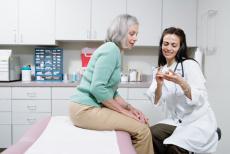 |
 |
 |
Other Health Topics:

-
Related Topics
-
Go Local
- Services and providers for Varicose Veins in the U.S.
-
National Institutes of Health
- The primary NIH organization for research on Varicose Veins is the National Heart, Lung, and Blood Institute
Varicose veins are enlarged veins that are swollen and raised above the surface of the skin. They can be dark purple or blue, and look twisted and bulging. Varicose veins are commonly found on the backs of the calves or on the inside of the leg. They develop when valves in the veins that allow blood to flow toward the heart stop working properly. As a result, blood pools in the veins and causes them to get larger.
Varicose veins affect 1 out of 2 people over age 50. They are more common in women than men. Hemorrhoids are a type of varicose vein. Spider veins are like varicose veins, but they are smaller.
Exercising, losing weight, elevating your legs when resting and not crossing them when sitting can help keep varicose veins from getting worse. Wearing loose clothing and avoiding long periods of standing can also help. If varicose veins are painful or you don't like the way they look, your doctor may recommend procedures to remove them.
-
Varicose Veins
 (National Heart, Lung, and Blood Institute)
(National Heart, Lung, and Blood Institute)
-
Varicose Veins
 (Patient Education Institute) - Requires Flash Player
(Patient Education Institute) - Requires Flash Player
Also available in Spanish
| Basics | Learn More | Multimedia & Cool Tools |
|---|---|---|
| Research | Reference Shelf | For You |
-
Overviews
- Spider/Varicose Veins(American Academy of Dermatology)
- Varicose Veins(Mayo Foundation for Medical Education and Research)
- Varicose Veins and Spider Veins(National Women's Health Information Center)
-
Diagnosis/Symptoms
-
Ultrasound - Venous (Extremities)(American College of Radiology, Radiological Society of North America)
Also available in Spanish
-
Ultrasound - Venous (Extremities)(American College of Radiology, Radiological Society of North America)
-
Treatment
- Sclerotherapy(American Society of Plastic Surgeons)
- What Treatments Are Effective for Varicose Veins?(Family Physicians Inquiries Network) - Links to PDF
-
Alternative Therapy
-
Bilberry
 (National Center for Complementary and Alternative Medicine)
(National Center for Complementary and Alternative Medicine)
-
Horse Chestnut
 (National Center for Complementary and Alternative Medicine)
(National Center for Complementary and Alternative Medicine)
-
Bilberry
-
Related Issues
- Chronic Venous Insufficiency(Society for Vascular Surgery)
-
Pictures & Photographs
- Spider Angioma(Logical Images)
- Telangiectasias(Logical Images)
-
Varicose Veins (Varicosities)
 (Logical Images)
(Logical Images)
-
Tutorials
-
Varicose Veins(Patient Education Institute) - Requires Flash Player
Also available in Spanish
-
Varicose Veins(Patient Education Institute) - Requires Flash Player
-
Videos
- Treatment of Varicose Veins through Laser Surgery(OR-Live) - Requires media player - One hour program
- VNUS Closure Procedure: Minimally Invasive Procedure to Treat Varicose Veins(OR-Live) - Requires media player - One hour program
-
Clinical Trials
-
ClinicalTrials.gov: Telangiectasis
 (National Institutes of Health)
(National Institutes of Health)
-
ClinicalTrials.gov: Varicose Veins
 (National Institutes of Health)
(National Institutes of Health)
-
ClinicalTrials.gov: Telangiectasis
-
Journal Articles
References and abstracts from MEDLINE/PubMed (National Library of Medicine)
- Article: Toe bandaging for lymphoedema and venous ulceration.
- Article: A prospective evaluation of the outcome after small saphenous varicose...
- Article: Impact of protein deficiency on venous ulcer healing.
- Varicose Veins -- see more articles
-
Directories
- Find a Dermasurgeon(American Society for Dermatologic Surgery)
- Find a Dermatologist(American Academy of Dermatology)
- Find a Plastic Surgeon(American Society of Plastic Surgeons)
- Find a Vascular Specialist(Society for Vascular Surgery)
- Find an Interventional Radiologist(Society of Interventional Radiology)
- Organizations Return to top
-
Children
- What Are Varicose Veins?(Nemours Foundation)
-
Men
- Varicocele(Mayo Foundation for Medical Education and Research)
| Home | Health Topics | Drugs & Supplements | Encyclopedia | Dictionary | News | Directories | Other Resources | |
| Disclaimers | Copyright | Privacy | Accessibility | Quality Guidelines U.S. National Library of Medicine, 8600 Rockville Pike, Bethesda, MD 20894 National Institutes of Health | Department of Health & Human Services |
Date last updated: 26 June 2008 Topic last reviewed: 04 July 2008 |






